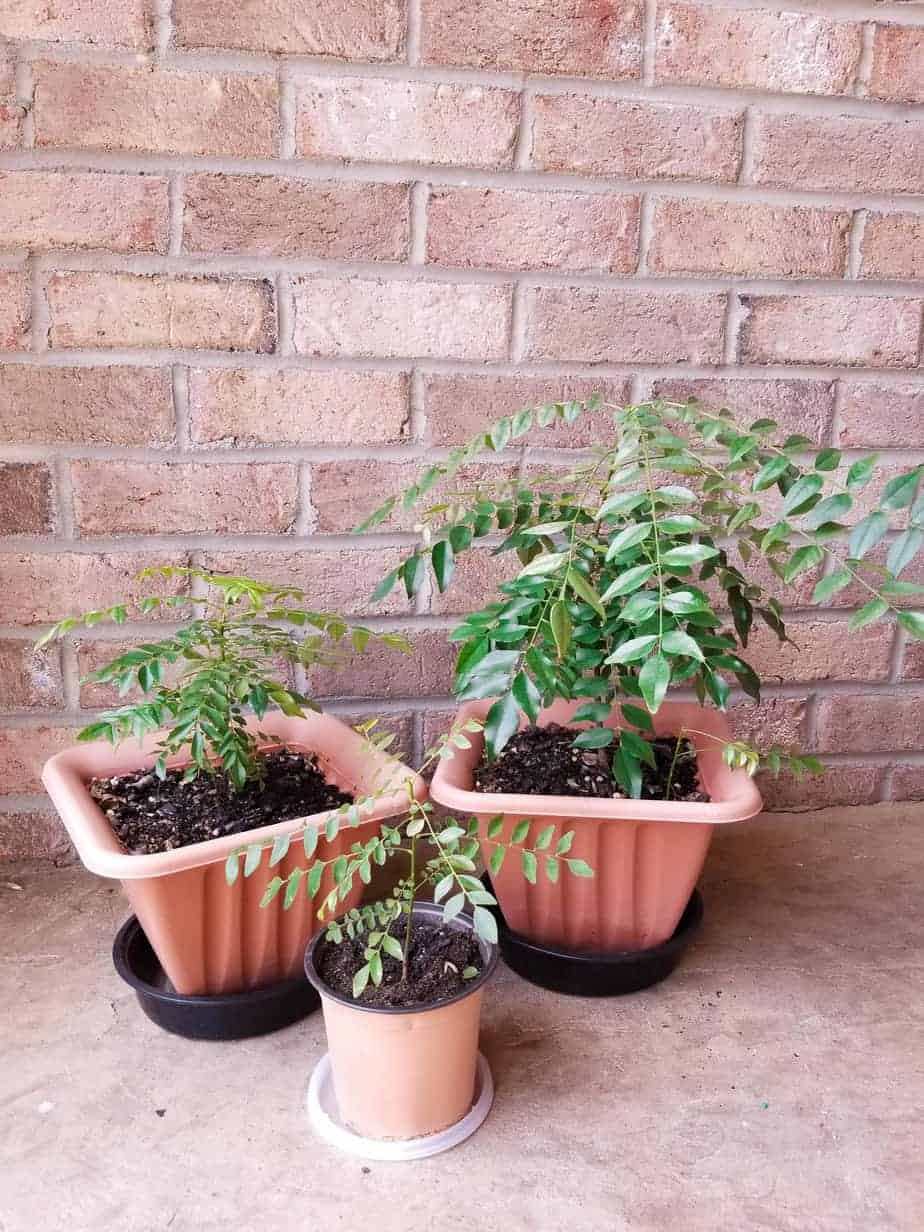In the last couple of days, I have received several inquiries through my Facebook Page, requesting more information regarding how to transplant or re-pot a Curry Leaf Plant or Kadi patta in a new pot.
Here’s what you need to do, once you buy a new baby Curry Leaf Plant (Check out this page: 3 Things To Consider When Buying A Curry Leaf Plant), or want to transplant an existing Curry Leaf Plant to a new container.
Being native to humid jungles of South East Asia, Curry leaf plant likes warm, humid weather. Curry Leaf plant will not survive below freezing temperature. If you live in an area where the temperature goes around or below freezing during winter, you should consider planting your Curry leaf plant in a pot or container which you can bring inside your house or move to a sheltered space.
Here is a complete Curry Leaf Plant Care guide.
When to Transplant/Re-pot a Curry Leaf Plant:
Early spring is the best time to transplant a curry leaf plant into a new container. If for some reason the middle of the year transplant is required, make sure to do it on a cloudy day during morning hours.
The Curry Leaf Plant doesn’t like its roots disturbed too frequently. Every time the plant is transplanted, it will go through a shock period, when it will stop growing for a while. For this reason, it is best to transplant a curry leaf plant only when needed. For example:Early spring is the best time to transplant a curry leaf plant into a new container. If for some reason the middle of the year transplant is required, make sure to do it on a cloudy day during morning hours.
– To transfer a baby Curry Leaf Plant from a starter pot to a bigger container.
– To change the current container soil of a mature plant- every two years is recommended.
– When you see the roots coming out of the drainage hole of the container- a bigger pot is needed.
What size pot is best for Curry Leaf Plant?
Any ceramic, resin or terracotta plastic container would work for Curry leaf plant. However, since most likely you’ll have to move the plant back and forth inside and outside the house seasonally, lightweight resin container is the best.
Whatever the material you choose for the container, make sure it has an adequate amount of drainage hole in the bottom of the container.
Picking the right size container for the curry leaf plant is essential. You do not want a huge container for a small plant.
When you transplant a Curry leaf plant in a new pot, the plant will divert its energy in growing the roots. Once the roots start touching the side of the container, the plant will focus energy on growing vertically by producing more leaves. For this reason, the container size should be in proportion to the plant size.
The newly transplanted Curry leaf plant can stay in this container for one to two years. In the spring after the transplant, you should consider whether the plan requires a new pot.
As a general rule of thumb, if the plant topples over in the windy conditions, the pot is too small for the plant. It’s time for a bigger pot.
Here’s my secret for keeping the Curry Leaf Plant happy and well watered:
Keep a shallow plastic dish or an empty takeout container under the Curry leaf plant container to catch the excess water. In the summer months, during a dry spell or heatwave, the curry leaf plant will soak up the excess water stored in the dish. That also reduces the frequency of watering the plant.

Best potting mix for Curry Leaf Plant:
The Curry Leaf Plant likes slightly acidic (Soil PH between 5.6 to 6 ), loose, and well-drained soil. After watering, the access water should run away from the drainage hole below the pot to prevent roots from rotting.
Any kind of potting mix available in the big box stores will work for the curry leaf plant. I recommend Cactus Potting Mix or Citrus Potting Mix. Make sure to buy the ‘Potting Mix,’ not the ‘Potting Soil.’ Add 1/2 amount of compost or cow manure to the potting mix for the best growth. Mix the potting mix and cow manure well before planting the curry leaf plant.
I do not recommend putting garden soil in the container. The garden soil has many bacteria, parasites, and insects that can infect or harm the growth of your Curry leaf plant. Additionally, when you bring the container indoors during colder months, you do not want to bring garden pests in that can infect other indoor plants.
Some people like to fill the container halfway with pebbles or plastic bottles before adding the soil, effectively reducing the soil required and making the container light when filled. I personally don’t implement this trick.
Okay, let’s gather your container gardening tools, and get started.
How to transplant a Curry Leaf Plant:
Step 1: Fill the container halfway with potting soil.
Step 2: Take out the Curry leaf plant from the current container. Gently ruffle the roots, if the roots are growing in the circular direction. Put the plant in the new container.
Step 3: Fill the container with the rest of the potting mix and compost mixture up to 1.5” to 2” inch below the edge of the container.
Step 4: Gently press around the base of the plant to take out any air bubbles trapped under the Soil.
Step 5: Sprinkle fertilizer like Blood Meal on the top later. Mix the top soil well.
Step 6: Pour water gently around the base of the plant until you see the water running out from the drainage hole of the pot. Wait for 5 to 10 minutes and then water again.
Step 7: Put the container in a warm, sunny spot. Make sure the plant receives 6 to 8 hours of direct sunlight every day.
How often to water a Curry Leaf Plant:
The Curry Leaf Plant does not like to be over-watered. If the plant gets too much water, the roots will start rotting. It is best to water the curry leaf plant infrequently but deeply. Water the plant when you see the topsoil is dry to touch.
Scratch on the top surface of the potting soil. If the soil below 0.5” of the surface is dry, it’s time to water. Water near the base of the plant until you see water running out from the bottom. Wait for a few minutes, and then water again.
Here is another secret tip:
Leaving the plant thirsty for an extra day makes the root grow longer. Over-watering does not help, but under-watering does!
Of course, use your best judgment during the hot summer months.
Best fertilizers for Curry Leaf Plants:
Apply Blood meal to the top layer of soil at the beginning of spring. Gently shuffle the top 2 to 3 inches of soil. Follow a regular schedule of liquid fertilizer like Neptune’s Seaweed and Fish Fertilizer. Continue until late summer.
Check out related article: Best Fertilizers For Curry Leaf Plant- Natural and Organic Options
If you have any question about planting your Curry leaf plant in a new container, please feel free to leave a comment below.
Want to know more about growing a Curry Leaf Plant?
- 3 Things to Consider Before Buying a Curry Leaf Plant
- Curry Leaf Plant Care Guide
- Best Fertilizers For Curry Leaf Plant- Natural And Organic Options
- How to prune a curry leaf plant to make it bushy
Ask your questions:
If you have any question regarding growing curry leaf plant or any other vegetable gardening matter, connect with me on Pinch of seeds group on Facebook. You can ask questions, post a picture for photo consultation, get personalized response and interact with other gardeners.
Last updated: 11/11/2020




Hi Gopi,
Really a great info. I love to grow plants but no green thumb. Highly depend on websites but unfortunately they all have not enough information. This time I bought two curry plants ,just In case if one dies I have another one. One website mentioned keep pinching from top and then I came across your website which said when to prune. My both plants are under one year so fingers cross. I live in Manhattan. I do have grow light at home. so let’s see how plants are going to survive their first winter. I love jasmine , and I hope you put information on that as well.
I got a curry leaves cutting with sprouted roots last summer and didn’t grow for so long, now from last couple of months all old leaves fall off and new baby leaves came but it falls off so fast, not sure what to do. Please advise I am growing it inside with partial sunlight
just to confirm, the bottom half of the container should be potting soil and then the rest will be potting mix? New to the gardening world and want to get it right!
I have tried growing a curry leaf plant many a times but the little sapling dies off. I stay in Hubli, Karnataka and I wanted to know if the sapling has to be covered with a plastic cover until it grows to a respectable height?
Covering plant with plastic would restrict the air circulation around the curry leaves plant. It would also invite fungul and other diseases on the plant. I would keep it in the open, airy location with good sunlight.
– Gopi
Hi!
I have a curry leave plant about 12 years old. It is in a pot as I need to bring it in, in the winter to protect it from freezing.
This year I am finding that the leaves are not looking healthy and are shedding snd I don’t see new leaves sprouting ( in the previous years by now I have had new leaves sprouting by now)
I repotted it about 1 year ago.
The roots of my plant fill the whole pot. I cannot find a bigger pot for it. Is it ok to cut and trim the roots? I don’t want to harm my plant Not sure if trimming the roots will hurt and ruin the plant.
I would appreciate if you could give me any suggestions.
I love my plant like my child !!! ??
Hope to hear from you soon.
Thank you
Vidya